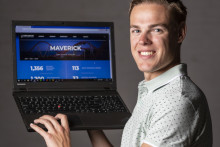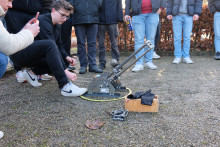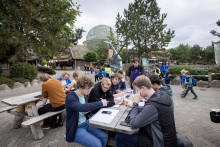Van den Hoorn’s (23) love of rollercoasters was born at an early age when he discovered the rollercoasters made of K’NEX. With those construction materials, he was able to build accurate scale models of real rollercoasters. ‘Things got quite out of hand, because the possibilities are endless. Over the years, I have built scale replicas of several real-life coasters, ranging from a wooden rollercoaster to a suspended model.’
When it was time to pick a study in the final year of his pre-university education, Van den Hoorn took a look around at the mechanical engineering programme in Twente. ‘On the first slide of their presentation, they showed off the various applications of mechanical engineering. One of the examples they gave was building rollercoasters. I was sold immediately.’
‘It was my dream to ultimately get a job at a rollercoaster manufacturer. However, when I learned that most of the businesses in that sector are based in southern Germany, Switzerland and the US, I thought it would never be more than a dream – until I heard about Intamin in Apeldoorn. This company calculates rollercoasters and other theme park rides for its parent company in Switzerland. One famous example is the Goliath in Walibi. My lecturer Jurnan Schilder knew the director of the company and because of that connection, I was able to start my final thesis project in a matter of weeks.’
‘A theme park has an idea or a concept for a new ride. Intamin in Apeldoorn then calculates the possibilities. What is the maximum load for the chain that has to pull up the rollercoaster’s cars? How thick should the beams that support the track be? What G-forces affect the passengers? A few Gs are fun for thrill seekers, but too many can be dangerous.’
‘During my final thesis project at Intamin, I worked on a project about a spinning coaster. With this model, the gondola can spin freely around its axis. I built a model of the coaster in a simulation programme and then gathered a wealth of data. These data allow us to calculate the minimal required bearing strength of the frame’s beams, for example. I was working on a method to translate the forces and moments into criteria for the load in a more accurate manner. Using this method, the tensions in the material can be calculated more precisely without a significant increase in processing time.’
‘My final thesis project fits well within the research into rollercoasters that UT lecturer Jurnan Schilder is working on. He supervises me from the University. His ultimate goal is to develop a model that simulates a rollercoaster as accurately as possible and with a minimal degree of uncertainty. Sometimes, a rollercoaster experiences fewer Gs in real life than in the simulation. In other words, it could have been even more spectacular. However, the G-forces may also be higher than expected, in which case part of the track has to be rebuilt.’







